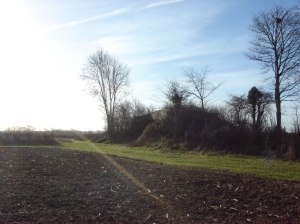 The story I submitted to Stroud Short Stories (see this blog to find out more about the night) was The Woman’s Wraith. This is, I think, one of the most spooky tales in the book, and is also one of the very first I chose to do. The story of the woman and … what she meets by a lonely bridge stayed with me long after I read the snippet from which we gleaned the tale.
The story I submitted to Stroud Short Stories (see this blog to find out more about the night) was The Woman’s Wraith. This is, I think, one of the most spooky tales in the book, and is also one of the very first I chose to do. The story of the woman and … what she meets by a lonely bridge stayed with me long after I read the snippet from which we gleaned the tale.
The story comes from a story collected by Adin Williams in his Lays and Legends of Gloucestershire, 1878, a delightful volume of, um, questionable verse capturing some of the south-east of the county’s folklore, history and art. For example, this is Oswyn from Hero Hengstan:
He was like a knotted oak, White with years that time had seared, Strong to give and take the stroke, When the battle fiercely neared.
Adin Williams was from Lechlade, and was a school master in Kempsford and Lechlade. He seems to have been a keen amateur historian and folklore collector, ‘the collection of curious local legends and histories, as far as old people can help to that end, has been the employment of his spare time’ , as it says in the preface to Lays and Legends. The Woman’s Wraith is one of a couple of collected tales in the end of the book from the ‘rich store of pathos and humour which is afloat in village gossip, but which,’ the publisher, CH Savory, says – and this is 1878, mark you! – ‘is fast wearing out before the stride of education and newspapers.’ Though not from Williams’ own teaching it seems – he was severely criticised for the quality of his teaching in Kempsford, where the Lays and Legends was written!
Williams says The Woman’s Wraith is ‘literally true’ – and who are we to doubt him? – and occurred within living memory of his writing – pushing it back to the 1810s or 20s. It’s set on the canal, which in this case can only be the Thames and Severn Canal, which meets the Thames just along from Kempsford at Lechlade. The Thames and Severn was completed in 1789, but even by the time of the story was starting its long decline, with trade taken by the Kennet and Avon which ran directly to the mouth of the Avon. When Williams was writing it may have been a quiet place indeed, just the sort of place where lonely, scary things might happen…
Today, the canal is gone. You can see it at the basin at Lechlade, and Inglesham lock, and imagine what it was like, but there is nothing left at Kempsford save tell-tale strips of grass near the church where you can see the line of the canal. But some of the infrastructure still remains – there’s the wharf house at Kempsford, and, out of the village, and marooned all alone in the fields is Oatlands Bridge.
There is something surreal about a bridge all alone in a field with no hint of water anywhere around. Something slightly … spooky … in its forlorn and overgrown state. It’s all too easy to imagine something lurking there, isn’t it? Perhaps the story was ‘literally true’, after all?
Note: information about Adin Williams comes from David Vasiey’s ‘Connections: Gloucestershire, the Bodleian Library, and the Adventures of Roger Plowman’ in Transactions of the Bristol and Gloucestershire Archaeological Society, vol. 111, 1993.


0 thoughts on “The Woman’s Wraith, a tale of the Thames and Severn Canal”